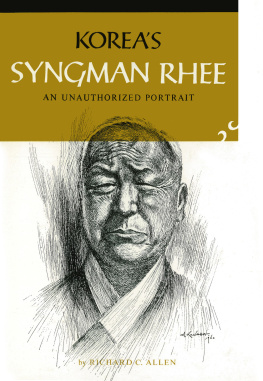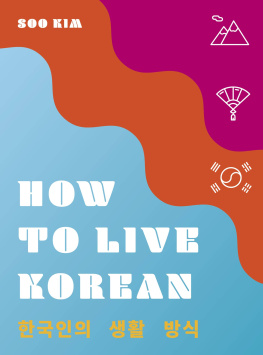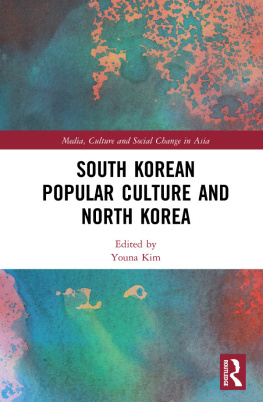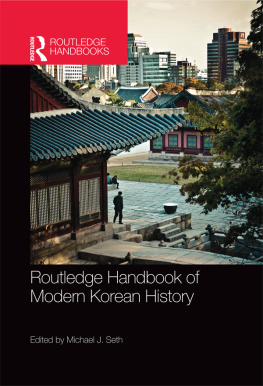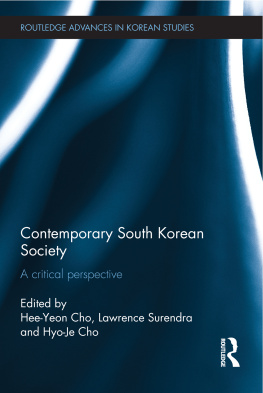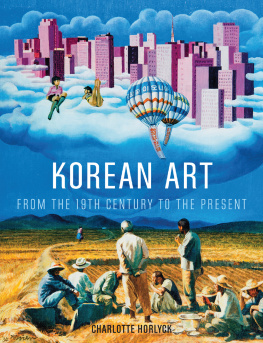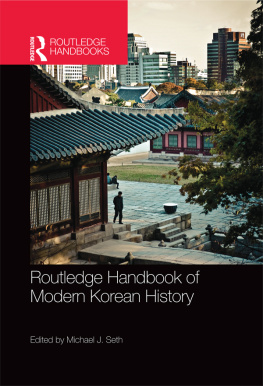KOREAN ART
KOREAN ART
FROM THE 19TH CENTURY TO THE PRESENT
CHARLOTTE HORLYCK
REAKTION BOOKS
Published by Reaktion Books Ltd
Unit 32, Waterside
4448 Wharf Road
London N1 7UX, UK
www.reaktionbooks.co.uk
First published 2017
Copyright Charlotte Horlyck 2017

The Korea Foundation has provided financial assistance for the undertaking of this publication project.
All rights reserved
No part of this publication may be reproduced, stored in a retrieval system, or transmitted, in any form or by any means, electronic, mechanical, photocopying, recording or otherwise, without the prior permission of the publishers
Page references in the Photo Acknowledgements and
Index match the printed edition of this book.
Printed and bound in China
A catalogue record for this book is available from the British Library
eISBN: 9781780237848
CONTENTS
NOTE TO READERS
T he Romanization follows the McCune-Reischauer system for Korean and the Hepburn system for Japanese. For the sake of consistency, all place names are Romanized using McCune-Reischauer and not the revised Romanization system introduced by the Korean government in 2000 (for example, Kwangju and not Gwangju, as it is spelled today). The exception applies to well-known persons and places, which have been established as standard usage (such as Seoul, Kim Il Sung and Chun Doohwan). This includes the scholar Kim Young-na (Kim Yng-na), whose publications in English and Korean are all referenced after the Western spelling of her name.
Korean and Japanese names appear with surnames listed first, except in the case of authors with publications in English. If a Korean name appears under a different spelling, it will be noted in brackets (for example, Lee Kyung-sung (Yi Kyng-sng)). Since many Korean surnames are identical, Korean names appear in full in all references. The names of many Korean artists do not follow conventional Romanization rules. In those cases, an artists preferred spelling is listed first, followed by the correct Romanization in brackets. In the glossary, their names are listed in Korean script.
Titles of artworks and exhibitions are provided in English translation unless when noted otherwise. Titles of newspapers, journals and magazines published in Korean are provided in the original.
All translations from Korean are my own, except when noted otherwise.
Abbreviations
J. Japanese
MMCA Museum of Modern and Contemporary Art, Seoul
PREFACE
T his book explores the making and use of art on the Korean peninsula from the closing decades of the nineteenth century to the first decades of the twenty-first century a period that witnessed enormous social change at an unprecedented rapid pace. It was also a revolutionary time in Koreas cultural history, characterized by the breakdown of artistic conventions and the rise of new art forms shaped by a changing social, political and economic environment. The richness of material and the complexities of political conjunctures challenge any attempt to present a definitive, encyclopaedic reading and there never was such an ambition for this volume. Nor was it the intention to focus on a particular material or genre of art as this approach would restrict the scope of the text. Instead, individual chapters cover specific events, artists and artworks that signify important points of departure and new directions in the arts of Korea. For this reason, chapters on colonial and post-war arts focus on painting, in particular the medium of oil which signals the advent of new approaches and styles. In contrast, the last chapter on arts from recent decades includes no mention of oil painting but covers a wide range of other media that reflect the diversity of the contemporary Korean art scene.
The decades covered in the text span the modern (kndae) and the contemporary (hyndae) eras. Debates on how the modern era should be defined and when it began are ongoing and scholars have put forward dates ranging from the reigns of kings Yngjo (r. 17241776) or Chngjo (r. 17761800) of the late Chosn kingdom (13921910) to the opening up of the country in 1876, the Kabo Reforms of 1894 and the Japanese annexation of Korea in 1910.
The beginning of contemporary art is an equally contested issue. Although the term hyndae was used during the colonial period to In the following I have loosely applied the term contemporary in references to art of the post-1980s.
A theme that runs through all the chapters is that of identity. It exemplifies the constant concern of Korean artists, critics and government institutions to determine specific styles, media and content that reflect local realities and traditions. The emphasis on identity stems from political events that unfolded on the Korean peninsula since the late nineteenth century onwards and highlights the close link between art and politics that underpins Korean cultural practices. Korea has had to defend its uniqueness since the end of the Chosn kingdom, when it was forced onto the international arena. When the Japanese colonized the peninsula, they suppressed the national identity of Koreans, essentially robbing them of their pride in their own history. The end of the colonial rule encouraged renewed discussions on Korean identity that soon became embedded into NorthSouth politics. They intensified after 1948 when the Democratic Peoples Republic of Korea (DPRK) and the Republic of Korea (ROK) were established on either side of the 38th parallel. During and after the Korean War (195053) both regimes encouraged the search for Korean identity in the arts as a means to further their respective political agendas. In the North this continues to be central to art practice. In the South, especially the 1980s witnessed a surge in artists explorations of cultural identity, framed by broader questions of collective identity, reunification, the colonial period and the Korean War. Recent decades have seen young artists approach notions of identity from individual perspectives, resulting in a diversity of responses.
The persistent focus on identity highlights the arguments on what Korea means to different groups of people, who may or may not identify as Korean. From a geographical point of view, Korea is the peninsula lodged between the Japanese archipelago and the Chinese mainland. However, in the West it tends to imply only the southern half and discussions of modern and contemporary Korean art typically centre on South Korea with little or no mention of the North. There are undeniable challenges in presenting a balanced view of arts produced in both Koreas, not least due to the difficulties in accessing reliable information on the North. Focusing on the early formation of socialist realism in North Korea, this book accounts for divergent as well as parallel courses in cultural practice between the two countries.
The question of how to define a Korean artist is linked to issues of national framings and identity. The Korean diaspora numbers close to seven million people spread over 170 countries. They include descendants of early immigrants as well as recent migrs. Several of the artists mentioned in this volume left Korea for America or Europe, often to pursue postgraduate studies, and some of them stayed abroad. They include Kimsooja (Kim Su-ja; 1957), Suh Do Ho (S Do-ho; 1962) and Yang Haegue (Yang Hye-gyu; 1971), to mention but a few. Long-term residents in America, such as Paik Nam June (Paek Nam-jun; 19322006) and Kang Ik-joong (Kang Ik-jung; 1960) are frequently referred to as Korean-American artists. For the purposes of this volume, I have focused on artists who identify themselves as Korean and whose works feature prominently on the Korean art scene and in Korean-led overseas projects.


